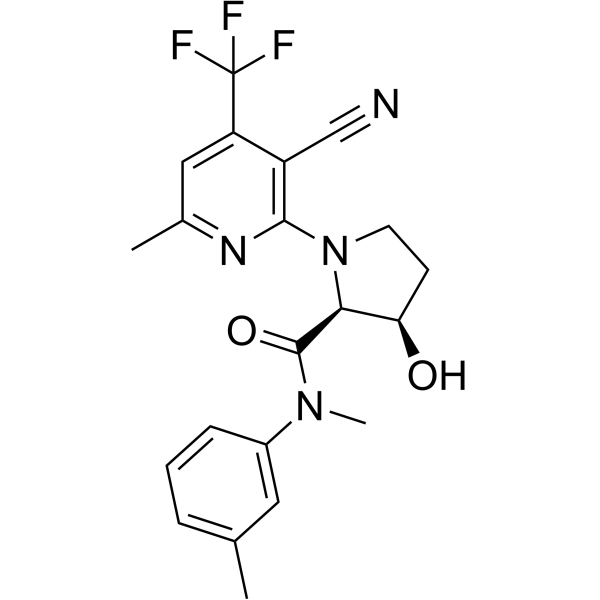
ART558
CAS No. 2603528-97-6
ART558( —— )
Catalog No. M28594 CAS No. 2603528-97-6
ART558 is a potent, selective, low molecular weight, allosteric DNA polymerase activity of Polθ inhibitor (IC50=7.9 nM). ART558 can be used for the research of cancer.
Purity : >98% (HPLC)
 COA
COA
 Datasheet
Datasheet
 HNMR
HNMR
 HPLC
HPLC
 MSDS
MSDS
 Handing Instructions
Handing Instructions
| Size | Price / USD | Stock | Quantity |
| 5MG | 372 | In Stock |


|
| 10MG | 556 | In Stock |


|
| 25MG | 887 | In Stock |


|
| 50MG | 1197 | In Stock |


|
| 100MG | 1611 | In Stock |


|
| 200MG | Get Quote | In Stock |


|
| 500MG | Get Quote | In Stock |


|
| 1G | Get Quote | In Stock |


|
Biological Information
-
Product NameART558
-
NoteResearch use only, not for human use.
-
Brief DescriptionART558 is a potent, selective, low molecular weight, allosteric DNA polymerase activity of Polθ inhibitor (IC50=7.9 nM). ART558 can be used for the research of cancer.
-
DescriptionART558 is a potent, selective, low molecular weight, allosteric DNA polymerase activity of Polθ inhibitor (IC50=7.9 nM). ART558 can be used for the research of cancer.(In Vitro):ART558 (5μM; 0~72 hours; BRCA2wild-type or BRCA2 / cells) shows γH2AX accumulation in cells. ART558 (0~10 μM; 7 days; BRCA2wild-type or BRCA2 / cells) shows synthetic lethality and a combinatorial effect with the PARPi olaparib in previously described isogenic models of BRCA1-deficiency. ART558 inhibits the major Polθ mediated DNA repair process, Theta-Mediated End Joining, without targeting NonHomologous End Joining. ART558 elicits DNA damage and synthetic lethality in BRCA1- or BRCA2-mutant tumour cells and enhances the effects of a PARP inhibitor. ART558 increases biomarkers of single-stranded DNA and synthetic lethality in 53BP1-defective cells whilst the inhibition of DNA nucleases that promote end-resection reversed these effects, implicating these in the synthetic lethal mechanism-of-action. ART558 increases the residence time of YFP-tagged full-length Polθ at sites of laserinduced DNA damage.
-
In VitroART558 (0~10 μM; 7 days; BRCA2wild-type or BRCA2?/? cells) shows synthetic lethality and a combinatorial effect with the PARPi olaparib in previously described isogenic models of BRCA1-deficiency.ART558 (5μM; 0~72 hours; BRCA2wild-type or BRCA2?/? cells) shows γH2AX accumulation in cells.ART558 inhibits the major Polθ mediated DNA repair process, Theta-Mediated End Joining, without targeting NonHomologous End Joining. ART558 elicits DNA damage and synthetic lethality in BRCA1- or BRCA2-mutant tumour cells and enhances the effects of a PARP inhibitor.ART558 increases biomarkers of single-stranded DNA and synthetic lethality in 53BP1-defective cells whilst the inhibition of DNA nucleases that promote end-resection reversed these effects, implicating these in the synthetic lethal mechanism-of-action. ART558 increases the residence time of YFP-tagged full-length Polθ at sites of laserinduced DNA damage. Cell Viability Assay Cell Line:BRCA2wild-type or BRCA2?/? cells Concentration:0~10 μM Incubation Time:7 days Result:Showed synthetic lethality and a combinatorial effect with the PARPi olaparib in previously described isogenic models of BRCA1-deficiency.Western Blot Analysis Cell Line:BRCA2wild-type or BRCA2?/? cells Concentration:5μM Incubation Time:0~72 hours Result:Showed γH2AX accumulation in cells.
-
In Vivo——
-
Synonyms——
-
PathwayCell Cycle/DNA Damage
-
TargetDNA/RNA Synthesis
-
RecptorACSS2
-
Research Area——
-
Indication——
Chemical Information
-
CAS Number2603528-97-6
-
Formula Weight418.41
-
Molecular FormulaC21H21F3N4O2
-
Purity>98% (HPLC)
-
SolubilityIn Vitro:?DMSO : 170 mg/mL (406.30 mM)
-
SMILESC(N(C)C1=CC(C)=CC=C1)(=O)[C@H]2N(CC[C@H]2O)C3=C(C#N)C(C(F)(F)F)=CC(C)=N3
-
Chemical Name——
Shipping & Storage Information
-
Storage(-20℃)
-
ShippingWith Ice Pack
-
Stability≥ 2 years
Reference
1.Philippe Nakache, et al. Acss2 inhibitors and methods of use thereof. Patent. WO2019097515A1.
molnova catalog



related products
-
DTP3 TFA
DTP3 TFA is a potent and selective GADD45β/MKK7 (growth arrest and DNA-damage-inducible β/mitogen-activated protein kinase kinase 7) inhibitor. DTP3 (10 μM; 1-21 days) causes the potent and tumor-selective induction of JNK activation and apoptosis.
-
Ddr1-In-1
DDR1-IN-1 is an effective and specific?DDR1?receptor tyrosine kinase inhibitor (IC50: 105 nM), about 3-fold selectivity over DDR2.
-
Treosulfan
Treosulfan is a bifunctional alkylating agent. It also has activity in ovarian cancer and other solid tumor types.



 Cart
Cart
 sales@molnova.com
sales@molnova.com


